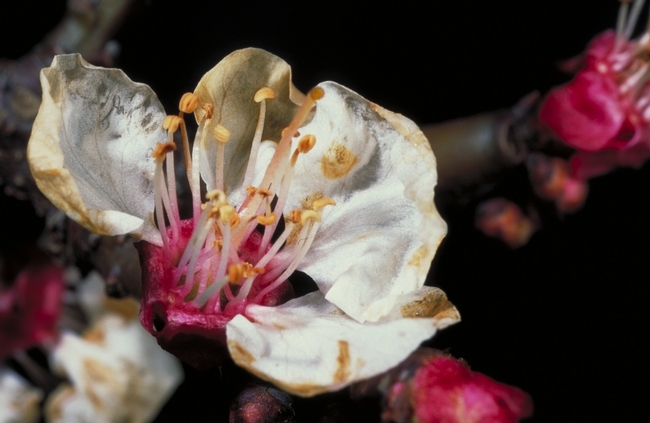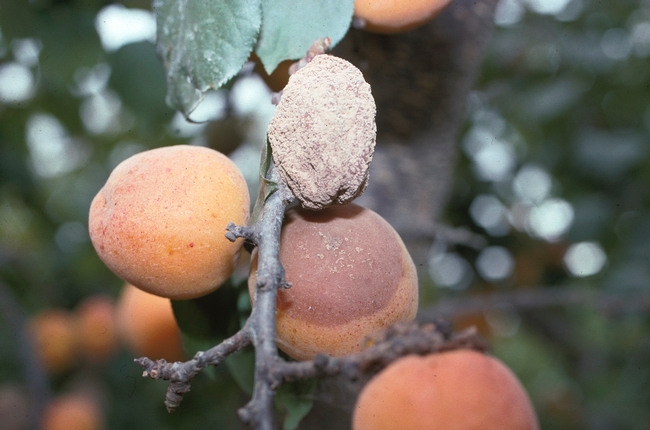Advice for the Home Gardener from the Help Desk of the
UC Master Gardener Program of Contra Costa County
Apricot Tree Showing Signs of Brown Rot
by Chantal Guillemin , Master Gardener
Request: My Royal (Blenheim) apricot tree usually produces delicious fruit, but this year almost all had brown discoloration. Globs of golden sap ooze out in many places along branches and the ends of some branches have brown, withered leaves and dead flowers. What kind of disease is affecting my apricot tree? What can I do about it?

Photo by Jack Kelly Clark, courtesy UC Statewide IPM Program
Response: Thanks for contacting the Help Desk of the UC Master Gardener Program of Contra Costa County about the problems with the brown spots appearing on your apricot fruit.
Expanding dark brown, firm, circular spots on apricots are symptomatic of a very common and serious disease of stone fruit called brown rot. The exudation (oozing) of sticky droplets of gum (sap) from the base of dead flowers and the bark of infected twigs is further indication that Monolinia spp., the brown rot fungus, is present on your apricot tree. Brown rot can also infect other stone fruit such as almond, peach, plum, cherry, nectarine and quince (a pome fruit).
The first symptom of brown rot is the browning and withering of blossoms. These infected blossoms cling to twigs for months. Cankers, which are sunken brown areas, may develop around twigs at the base of infected flowers, causing leaves at tips of twigs to become dark brown and shrivel up.

Photo by William W. Coates, courtesy UC Statewide IPM Program
Gardeners in Contra Costa County can practice the following sanitation measures to decrease the spread of brown rot fungal disease: frequent checking of stone fruit trees for signs of brown rot, timely and appropriate pruning, furrow or drip irrigating versus overhead sprinklers, and planting disease tolerant varieties.
Inspect your apricot and other stone fruit trees nearby often for symptoms of brown rot. Do this during the bloom period, as fruit turn green, and when they begin to ripen. Consider harvesting fruit before it is ripe but once it is soft will lessen the risk of brown rot. After harvest, remove all fruit left on trees or destroy them because they are potential overwintering sites for brown rot. Ensuring that gardening sanitation tasks are performed on a regular basis will go a long way to minimizing the development of spores from mummified fruit hidden beneath weeds and debris on the ground.
As for apricot trees, pruning should never be done during winter dormancy. That's our wet season, and atmospheric moisture carries airborne spores and pathogens. Apricot and cherry trees are particularly susceptible to Eutypa dieback, a disease which causes whole branches to wither away. Do not inflict pruning wounds on apricot trees at this time. Pruning diseased twigs and dead blossoms still clinging to branches of apricot trees should be done after leaves drop but before the first fall rains.
Other stone fruit require the same removal of infected plant tissue but this can be done as soon as these are detected. Burn, bury or bag all diseased branches and leaves. Destruction of these affected parts and the removal of mummies from the tree and from beneath the tree prevents the buildup of brown rot inoculum. This applies to flowering cherry, plum and quince as well. Do not put diseased plant parts in compost. Remove broken or diseased branches. Prune trees from the time they are planted to allow good ventilation in the canopy.
Avoid wetting blossoms, foliage, and fruit during irrigation by using furrow or drip irrigation. As far as prunes are concerned, drying them immediately after harvest kills the brown rot fungus.
Some plant varieties are known to be least susceptible to brown rot. Apricot cultivars Tilton, Harcot, and Harglow are touted to have some brown rot resistance. Royal, Blenheim, Perfection, and Derby Roal are most susceptible to this fungal infection.
If left unmonitored, brown rot fungal infection of apricots and other stone fruit can thwart homeowner's plans for a harvest of healthy fruit. Familiarization with brown rot symptoms and taking action to remove sources of brown rot spores can alleviate the problem of brown rot fungal infection on apricots and other stone fruit.
For additional information, you can also consult:
UCANR publication 7259, Apricots: Calendar of Operations for Home Gardeners;
UCANR publication Pests in Garden and Landscapes – Brown Rot Monilinia spp.;
UCANR publication 3332, Pests of the Garden and Small Farm, pp 144-145;
UCANR publication 3382, California Master Gardener Handbook Chapter 16
UCANR publication 3311, Postharvest Technology of Horticultural Crops;
UCANR publication 3345, Diseases of Temperate Zone Tree Fruit and Nut Crops;
UCANR publication 3485, The Home Orchard
Those not available as free download UC publications are often available at your local branch library or by mail order from UCANR.
Please do not hesitate to contact the MGCC'S Help Desk if you have further questions and/or need recommendations.
Help Desk of the UC Master Gardener Program of Contra Costa County (CCG)
Note: The UC Master Gardeners Program of Contra Costa's Help Desk is available almost year-round to answer your gardening questions. Except for a few holidays (e.g., last 2 weeks December), we're open every week, Monday through Thursday for walk-ins from 9:00 am to Noon at 2380 Bisso Lane, Concord, CA 94520. We can also be reached via telephone: (925) 608-6683, email: ccmg@ucanr.edu, or on the web at http://ccmg.ucanr.edu/Ask_Us/. MGCC Blogs can be found at http://ccmg.ucanr.edu/HortCoCo/ You can also subscribe to the Blog (//ucanr.edu/blogs/CCMGBlog/)